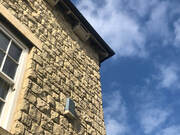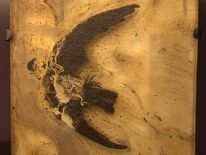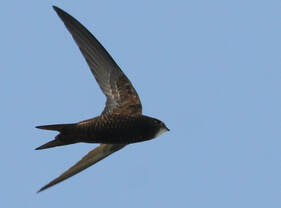|
Swifts just are the most amazing creatures! We're already determined to do everything we can to support our Tisbury swifts, but Edward Mayer's immense knowledge and contagious enthusiasm has made us even more convinced of the urgent need to do this. He made the point at the outset that these are birds that we humans really can help: find out more about our campaign by searching under Swifts Project in the Categories to the right. Edward told us that their story began around 49m years ago, as fossils looking much like today's swifts are found over much of Europe dating back that far. Humans have been around for 150m years, so we've been enjoying swifts for half our existence. But now, because of us, they are in danger: numbers are down by over 50% in the UK alone, between 1995 and 2015 according to the BTO. We need to do something to stop this, first because swifts provide a very valuable service which certainly contributes to our general well-being. They eat thousands and thousands of insects that would otherwise make our lives a misery or ruin our crops. This is becoming an ever more urgent requirement: at the same time as the swift population declines, global warming is bringing different species of insects from Africa into Europe. Latest arrival in France is the tiger mosquito which carries tropical diseases such as dengue feaver, West Nile virus and chickengunya - treatable but not always curable. But it's the overall decline in insect life eg of 80% between 1981 and 2013 that along with disappearing nest sites that is more of a problem. Most of that is due to the farming practices ie the preference for chemical treatment instead of more sustainable – indeed regenerative – methods which, thankfully, are becoming more widespread (see Peter Thompson's talk on 19 November, summarised below). But the other reason is that without swifts joyfully screaming overhead, our summers especially in our villages, towns and cities, would be miserably silent! Swifts originally nested in very large, old trees and some are still doing this in the Abernethy Forest in Scotland, a nature reserve that includes remnants of the ancient Caledonian Forest, and also in the ancient Bialoweza Forest on the Poland-Belorus border. But now they're mainly urban birds – so much so that the German word for swift is Mauersegler which means wall-sailor. Our swifts make a return journey of 14,000 miles to South East Africa and back, every single year, at an altitude of around 8000 feet and taking just 16 days each way. It is their construction that makes this possible and for almost every aspect of their lives to be carried out in mid-air, from grooming to mating – and it's been studied by scientists designing modern aircraft. Their wings rotate at the base - this gives them extraordinary agility as in this video which we posted before the talk. This inspired the design of swing-wing planes including the F111 fighter jet. Hummingbirds have this same feature, which enables them to hover, and they are descended from the same prehistoric ancestor. Swifts' wings are also extremely thin and this 'high aspect ratio' provides exceptional 'fuel economy'. It means they can fly for four days across the Gulf of Guinea in West Africa without food – no insects over water – or drink. And it's this same feature that makes the Dreamliner popular with the airlines! Swifts always return to the same nest site and if they find this closed or disappeared, they won't breed that year. The destruction of nests is a major factor in the decline in swift populations – down by 57% in Europe between 1995 and 2017. But if such work is essential, information on how to preserve the colony is given in the Swift Conservation leaflets. Nor will they breed if they've been short of food on the way, or have met unseasonably cold weather – this happened last year in Greece. But if the nest site is safe they can continue to breed for up to 20 years, beginning when they're three years old ie have successfully completed their migration three times.  Photo: Elizabeth Forbes Photo: Elizabeth Forbes Often, swifts nest in a minute opening at the top of stone- or brickwork with enough space on a flat surface behind – this is the entrance to the nest on my house. Nests aren't luxurious, just whatever swifts can catch in the sky – bits of grass, feathers etc The sexes migrate separately, but the sooner they get back to the nest site and start fattening themselves up the better, because the young only leave the nest when fully fledged, and this takes around 6 weeks. I did once witness one fledging from the nest on my house and I'll never forget it. I'd been observing the little white face peeping out, and one evening it launched itself out with a sharp clap of wings, and was gone. Comments are closed.
|
Photo: Avocets (Izzy Fry)
The headers display photos taken by our members. Do get in touch via the Contact Form if you'd like to submit a photo for selection.
Archives
May 2024
Categories
All
|



 RSS Feed
RSS Feed